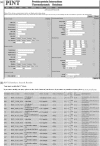PINT: Protein-protein Interactions Thermodynamic Database
- PMID: 16381844
- PMCID: PMC1347380
- DOI: 10.1093/nar/gkj017
PINT: Protein-protein Interactions Thermodynamic Database
Abstract
The first release of Protein-protein Interactions Thermodynamic Database (PINT) contains >1500 data of several thermodynamic parameters along with sequence and structural information, experimental conditions and literature information. Each entry contains numerical data for the free energy change, dissociation constant, association constant, enthalpy change, heat capacity change and so on of the interacting proteins upon binding, which are important for understanding the mechanism of protein-protein interactions. PINT also includes the name and source of the proteins involved in binding, their Protein Information Resource, SWISS-PROT and Protein Data Bank (PDB) codes, secondary structure and solvent accessibility of residues at mutant positions, measuring methods, experimental conditions, such as buffers, ions and additives, and literature information. A WWW interface facilitates users to search data based on various conditions, feasibility to select the terms for output and different sorting options. Further, PINT is cross-linked with other related databases, PIR, SWISS-PROT, PDB and NCBI PUBMED literature database. The database is freely available at http://www.bioinfodatabase.com/pint/index.html.
Figures

Similar articles
-
ProTherm, version 4.0: thermodynamic database for proteins and mutants.Nucleic Acids Res. 2004 Jan 1;32(Database issue):D120-1. doi: 10.1093/nar/gkh082. Nucleic Acids Res. 2004. PMID: 14681373 Free PMC article.
-
Thermodynamic database for proteins: features and applications.Methods Mol Biol. 2010;609:97-112. doi: 10.1007/978-1-60327-241-4_6. Methods Mol Biol. 2010. PMID: 20221915
-
SCOWLP: a web-based database for detailed characterization and visualization of protein interfaces.BMC Bioinformatics. 2006 Mar 2;7:104. doi: 10.1186/1471-2105-7-104. BMC Bioinformatics. 2006. PMID: 16512892 Free PMC article.
-
Thermodynamic databases for proteins and protein-nucleic acid interactions.Biopolymers. 2001-2002;61(2):121-6. doi: 10.1002/1097-0282(2002)61:2<121::AID-BIP10077>3.0.CO;2-1. Biopolymers. 2001. PMID: 11987161 Review.
-
Large macromolecular complexes in the Protein Data Bank: a status report.Structure. 2005 Mar;13(3):381-8. doi: 10.1016/j.str.2005.01.008. Structure. 2005. PMID: 15766539 Review.
Cited by
-
Constraints imposed by non-functional protein-protein interactions on gene expression and proteome size.Mol Syst Biol. 2008;4:210. doi: 10.1038/msb.2008.48. Epub 2008 Aug 5. Mol Syst Biol. 2008. PMID: 18682700 Free PMC article.
-
Real value prediction of protein folding rate change upon point mutation.J Comput Aided Mol Des. 2012 Mar;26(3):339-47. doi: 10.1007/s10822-012-9560-3. Epub 2012 Mar 18. J Comput Aided Mol Des. 2012. PMID: 22426539
-
Structure-based inhibition of protein-protein interactions.Eur J Med Chem. 2015 Apr 13;94:480-8. doi: 10.1016/j.ejmech.2014.09.047. Epub 2014 Sep 16. Eur J Med Chem. 2015. PMID: 25253637 Free PMC article. Review.
-
Biomolecular Topology: Modelling and Analysis.Acta Math Sin Engl Ser. 2022;38(10):1901-1938. doi: 10.1007/s10114-022-2326-5. Epub 2022 Oct 15. Acta Math Sin Engl Ser. 2022. PMID: 36407804 Free PMC article.
-
Optimality of mutation and selection in germinal centers.PLoS Comput Biol. 2010 Jun 3;6(6):e1000800. doi: 10.1371/journal.pcbi.1000800. PLoS Comput Biol. 2010. PMID: 20532164 Free PMC article.
References
-
- Salwinski L., Eisenberg D. Computational methods of analysis of protein–protein interactions. Curr. Opin. Struct. Biol. 2003;13:377–382. - PubMed
-
- Wodak S.J., Mendez R. Prediction of protein–protein interactions: the CAPRI experiment, its evaluation and implications. Curr. Opin. Struct. Biol. 2004;14:242–249. - PubMed
-
- Aloy P., Pichaud M., Russell R.B. Protein complexes: structure prediction challenges for the 21st century. Curr. Opin. Struct. Biol. 2005;15:15–22. - PubMed
MeSH terms
Substances
LinkOut - more resources
Full Text Sources
Other Literature Sources

